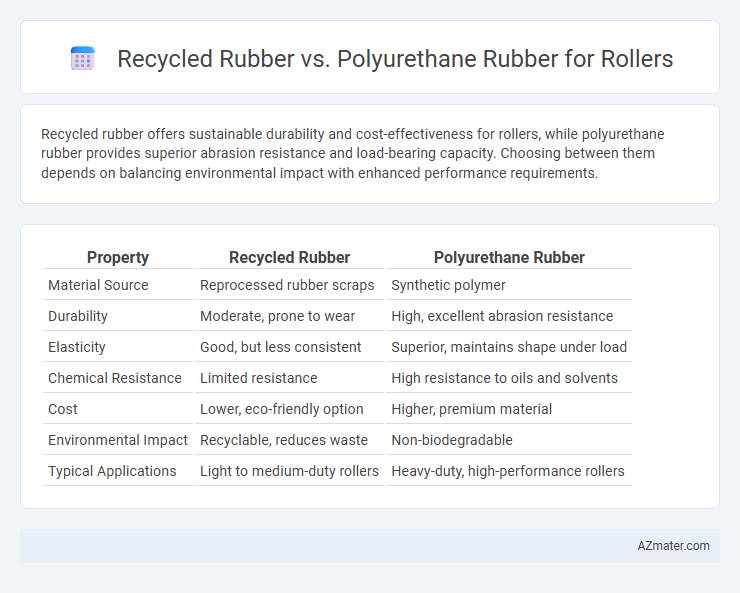Recycled rubber offers sustainable durability and cost-effectiveness for rollers, while polyurethane rubber provides superior abrasion resistance and load-bearing capacity. Choosing between them depends on balancing environmental impact with enhanced performance requirements.
Table of Comparison
| Property | Recycled Rubber | Polyurethane Rubber |
|---|---|---|
| Material Source | Reprocessed rubber scraps | Synthetic polymer |
| Durability | Moderate, prone to wear | High, excellent abrasion resistance |
| Elasticity | Good, but less consistent | Superior, maintains shape under load |
| Chemical Resistance | Limited resistance | High resistance to oils and solvents |
| Cost | Lower, eco-friendly option | Higher, premium material |
| Environmental Impact | Recyclable, reduces waste | Non-biodegradable |
| Typical Applications | Light to medium-duty rollers | Heavy-duty, high-performance rollers |
Introduction to Roller Materials: Recycled Rubber vs Polyurethane
Recycled rubber rollers offer durability and cost-efficiency, making them suitable for applications requiring impact resistance and flexibility. Polyurethane rollers provide superior abrasion resistance, load-bearing capacity, and chemical stability, ideal for high-precision industrial processes. Material selection depends on operational demands, with recycled rubber favored for sustainability and polyurethane preferred for enhanced performance in high-stress environments.
Material Composition and Manufacturing Processes
Recycled rubber for rollers is primarily composed of shredded rubber from used tires or industrial scrap, blended with binders and additives, whereas polyurethane rubber consists of synthetic polymers derived from isocyanates and polyols. Manufacturing recycled rubber rollers involves processes like grinding, mixing, molding, and vulcanization to enhance elasticity and durability, while polyurethane rollers are produced through precise chemical reactions that create a uniform, dense elastomer with superior abrasion resistance. The choice between recycled and polyurethane rubber impacts roller performance, with recycled rubber offering cost-effective sustainability and polyurethane providing enhanced mechanical strength and chemical resistance.
Environmental Impact and Sustainability
Recycled rubber rollers significantly reduce landfill waste and lower carbon emissions by repurposing materials from used tires, making them a sustainable choice for eco-friendly manufacturing. Polyurethane rubber rollers, although durable and resistant to wear, involve petrochemical-based production processes that contribute to higher environmental footprints and limited biodegradability. Choosing recycled rubber rollers supports circular economy principles and minimizes resource depletion compared to polyurethane alternatives.
Durability and Lifespan Comparison
Recycled rubber rollers offer moderate durability with a typical lifespan of 3-5 years, benefiting from eco-friendly material reuse but often showing faster wear under heavy industrial loads. Polyurethane rubber rollers exhibit superior durability, resisting abrasion, chemicals, and impacts, resulting in a lifespan that can extend beyond 7-10 years in demanding applications. The enhanced wear resistance and toughness of polyurethane make it the preferred choice for high-performance rollers requiring long-term reliability and minimal maintenance.
Performance in Industrial Applications
Recycled rubber rollers offer excellent cost-efficiency and environmental benefits, with good abrasion resistance but tend to have lower durability and chemical resistance compared to polyurethane rubber rollers. Polyurethane rubber rollers provide superior performance in industrial applications due to their high tensile strength, exceptional wear resistance, and strong resistance to oils, solvents, and chemicals, making them ideal for heavy-duty use. The choice between recycled and polyurethane rubber rollers depends on application-specific requirements such as load capacity, exposure to harsh chemicals, and expected lifespan.
Cost Efficiency and Long-term Value
Recycled rubber rollers offer significant cost efficiency due to lower material and manufacturing expenses, making them a budget-friendly choice for short-term applications. Polyurethane rubber rollers provide superior durability, abrasion resistance, and load-bearing capacity, resulting in longer service life and reduced maintenance costs. The long-term value of polyurethane rollers often outweighs initial savings from recycled rubber by minimizing replacement frequency and operational downtime.
Maintenance Requirements and Ease of Repair
Recycled rubber rollers typically require more frequent maintenance due to their lower resistance to wear, abrasion, and chemical exposure compared to polyurethane rubber rollers, which offer superior durability and longer service life. Polyurethane rollers resist cracking and deformation, reducing downtime and making repair processes simpler and less frequent. Repairing polyurethane rubber rollers is often more straightforward due to their uniform composition, whereas recycled rubber may exhibit inconsistent quality that complicates patching and surface restoration.
Shock Absorption and Noise Reduction Capabilities
Recycled rubber rollers exhibit superior shock absorption due to their elastic properties, effectively minimizing impact forces and vibrations in industrial applications. Polyurethane rubber rollers offer enhanced noise reduction capabilities by dampening sound waves through their dense, durable composition. Selecting between these materials depends on balancing the need for high shock absorption with noise mitigation requirements in roller systems.
Customization Options and Design Flexibility
Recycled rubber rollers offer limited customization options due to their fixed material properties and lower processing adaptability, making them less suitable for intricate design requirements. Polyurethane rubber rollers provide superior design flexibility, allowing for precise hardness variations, enhanced abrasion resistance, and tailored elasticity to meet specific application needs. Manufacturers favor polyurethane for bespoke roller solutions where performance and durability are critical.
Industry Recommendations and Use Cases
Recycled rubber rollers are favored in industries prioritizing sustainability and cost-efficiency, such as packaging and printing, due to their excellent shock absorption and environmental benefits. Polyurethane rubber rollers are recommended for applications requiring high wear resistance, chemical stability, and precision, including automotive manufacturing and conveyor systems. Industry standards highlight polyurethane rollers for heavy-duty use and longer lifespan, whereas recycled rubber suits moderate duty environments with eco-friendly objectives.

Infographic: Recycled rubber vs Polyurethane rubber for Roller
 azmater.com
azmater.com